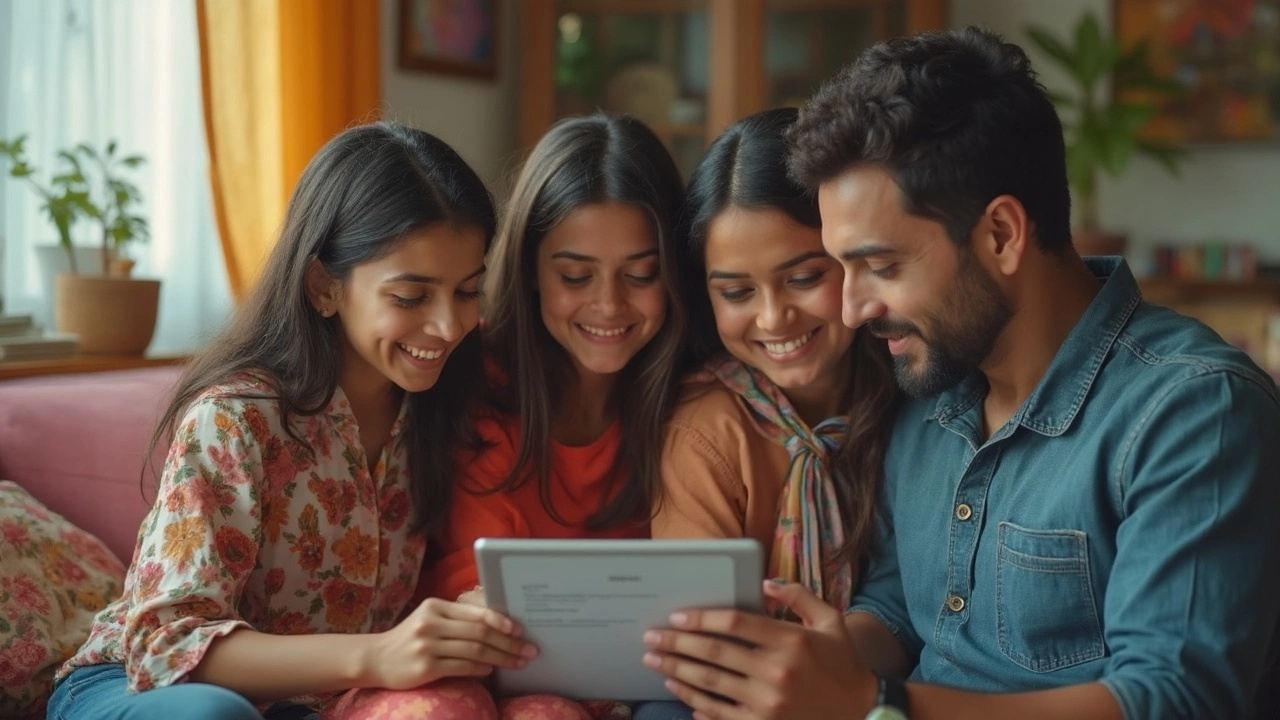 Jun, 18 2025
Jun, 18 2025
Trying to open a bank account in India while working or living in another country? You’re definitely not alone. There are a ton of NRIs (Non-Resident Indians), students, and even expats who want a local Indian bank account for everything from sending money home to managing investments.
Here’s some good news: You don’t need to show up at a branch in person anymore. Most big Indian banks—think SBI, HDFC, ICICI, and Axis—now let you apply online. It’s not magic, but it is a lot smoother than the old paper-heavy process. Still, there are some details you need to know, especially since the rules differ for residents, NRIs, and OCIs (Overseas Citizens of India).
It pays off to get familiar with the online account types, required documents, and the exact process, so you don’t get stuck waiting for weeks after making even a small mistake. Some banks now even offer video KYC (Know Your Customer), which means a video call can replace an in-person visit. This saves a lot of hassle—no more mailing notarized forms across continents.
- Who Can Open an Account from Abroad?
- Documents You Need
- The Online Account Opening Process
- Real-World Tips and Pitfalls
Who Can Open an Account from Abroad?
Not everyone can just hop online and get an Indian bank account from a foreign country. The rules are pretty clear, and they mostly revolve around your residency and citizenship status. Here’s the deal:
- NRI (Non-Resident Indians): If you’re an Indian citizen living abroad for work, studies, or business for more than 183 days a year, you fit in this group. Banks roll out special account options like NRE (Non-Resident External) and NRO (Non-Resident Ordinary) accounts just for you.
- OCI (Overseas Citizen of India): If you’ve got OCI status (basically a long-term visa for people who can claim Indian roots), you can get an account online, too, with access to the same types as NRIs.
- PIO (Person of Indian Origin): This is similar to OCI, but if you’re holding a PIO card, you can apply as well—though PIO cards have been merged with OCI recently, so just check your paperwork.
- Foreign Nationals: You’re not eligible to open most standard Indian savings accounts online unless you’ve got a specific long-term work or student visa. Even then, you may need to jump through some extra hoops at a bank branch first.
- Indian Residents: If you’re just temporarily abroad (like a student on a six-month exchange), most banks will insist you switch to an NRI account after 182 days outside India.
Banks always check your status, so don’t try to game the system. The type of account you qualify for depends on what documents you can provide and your actual legal status. Here’s a quick rundown of which account types are open for each group:
| Status | Account Types Available Online | Special Requirements |
|---|---|---|
| NRI | NRE, NRO, FCNR | Overseas address proof, valid visa |
| OCI | NRE, NRO, FCNR | OCI card copy |
| PIO | NRE, NRO | PIO card copy |
| Foreign National | Usually not available online | Work/student visa, physical branch visit |
| Indian Resident (temporarily abroad) | May need to convert to NRI account | If abroad over 182 days |
If you’re applying as an NRI, most major banks accept genuine applications online and may even let you do a video KYC for the final check. Just be honest about your status from the start, because they run background checks, and fibbing can get your account flagged or frozen. As of last year, close to 8% growth was seen in NRI deposits, with SBI grabbing almost a quarter of all such accounts digitally, showing more NRIs are ditching the paperwork and going online.
Documents You Need
No one likes paperwork, but getting your documents in order is probably the most important step if you want to open bank account India online from abroad. Indian banks are fussy about knowing exactly who you are and where you live now, especially with all the RBI anti-fraud rules.
Here’s the basic document checklist nearly every bank will ask for:
- Passport – Main proof of identity. The first and last page copies, clear and preferably in color.
- Visa/Residence Permit – This shows you’re legally in your current country. If you’re in the Middle East or Europe, attach a copy of your resident card or long-term visa.
- Overseas Address Proof – Utility bill, bank statement, or government letter that’s less than 3 months old. Has to show your current address abroad, not your old address in India.
- Indian Address Proof (optional, but helpful) – If you still have an Indian address (like family home), add an Aadhaar card, driver’s license, or old utility bill.
- Recent Passport-size Photos – Usually two. Some banks want digital photos uploaded with your application.
- Filled Application Form – Every bank has a specific online form; double-check the details before you hit submit.
If you apply for an NRE (Non-Resident External) or NRO (Non-Resident Ordinary) account, banks might also need:
- Copy of PAN card (for tax compliance)
- Self-declaration of NRI/OCI status
- Foreign bank statement (sometimes required if their risk team is extra careful)
All scanned documents should be crystal clear. If anything’s blurry or cropped, your application might get stuck for weeks.
Some banks require attestation. This means you need the documents verified by the local Indian embassy, a notary, or your bank overseas. For instance, according to a 2024 SBI memo, online NRI account applications must have attested copies of ID and address proof, unless video KYC is successfully completed.
| Document | Attestation Needed? | Acceptable Formats |
|---|---|---|
| Passport | Yes, if no video KYC | PDF/JPEG |
| Residence Permit | Yes, if bank states | PDF/JPEG |
| Overseas Address Proof | Yes, for most banks | PDF/JPEG |
| PAN Card | No (but must match name on passport) | PDF/JPEG |
One odd issue: if your signatures on documents don’t match exactly, Indian banks will often reject the application. So sign everything the same way you signed your passport.
Quick tip: Have soft copies ready, under 1MB per file. If you’re in a country where scanners are hard to find, apps like Adobe Scan on your phone are a lifesaver. Save everything to a Google Drive or Dropbox folder so you can upload them fast on any bank’s portal.

The Online Account Opening Process
If you’re ready to open a bank account online in India from abroad, here’s what you can really expect. The process is pretty straightforward, but Indian banks love paperwork and steps, so staying organized will save you a ton of frustration.
- Choose your bank and account type: Nearly all major Indian banks like SBI, HDFC, ICICI, and Axis offer online account opening for NRIs and foreigners. Most people go for NRE (Non-Resident External) or NRO (Non-Resident Ordinary) accounts. NRE is best for holding foreign earnings, while NRO works for income earned in India.
- Visit the bank’s website: Click on their NRI section or 'open account online' page. These days, banks push their online portals or dedicated apps for the purpose. Avoid random links; always use the official bank website.
- Online application form: Fill in your personal details. You’ll need to provide your passport number, overseas address, Indian address (if you have one), and visa details. Make sure info matches your documents or the application could get rejected.
- Document upload: Scan and upload copies of your documents—passport, visa, proof of address (both in India and abroad), and a recent photo. Some banks need these to be self-attested, so simply sign underneath before scanning. A few banks may also request notarization by the Indian embassy or a notary in your country, though this is becoming rare with digital verification.
- Video KYC: This is a recent development and it’s a real game changer. Once you’ve submitted your application, many banks schedule a live video call for 'Know Your Customer' verification. You’ll need good internet, your original documents handy, and a camera. During the call, the bank officer will match your face to your ID and ask a few simple questions.
- Initial deposit: Some banks need you to make a minimum first deposit—usually anywhere from ₹5,000 to ₹10,000 for NRIs. This can be sent from your foreign bank account via wire transfer or remittance platforms.
- Account approval and activation: If everything is in order, your account is generally active within 3-7 working days. You’ll get your account number by email, and soon after, your debit card and checkbook are sent to your registered address—some banks can even send these internationally for a fee.
If you’re in a hurry, go for banks that clearly mention instant digital account opening or 'Quick NRI Account.' Sometimes, smaller banks are a bit slower or may want you to mail hard copies, so stick to the majors if speed is a priority.
Keep a screenshot of your application reference number, just in case you need to follow up. If any issues come up, Indian banks are surprisingly responsive over WhatsApp or email nowadays, especially for NRI customers. This makes the process smoother than ever before.
The keyword you should remember here is open bank account India online. That’s what makes this process possible if you’re sitting thousands of miles away from home.
Real-World Tips and Pitfalls
If you want to open bank account India online from outside the country, real life can throw up some surprises. Official websites make it sound super smooth, but it’s easy to run into things that slow you down or get your application rejected. Here’s what really matters and what you should watch out for.
- Always double-check your details: Banks in India are super strict about matching names and addresses across your documents (passport, overseas address proof, etc). A small spelling difference is enough to get your application stuck for weeks.
- Know your document requirements: Some banks ask for docs to be notarized or attested by the Indian Embassy in your country. Miss this, and you might need to start over. Some have moved to video KYC, but not all—so check before you pick your bank.
- Bank choices matter: Did you know not all banks allow for instant online account opening from outside India? Private players (HDFC, ICICI) are usually faster with digital onboarding, while government banks might ask for physical documents.
- Watch for minimum balance rules: NRE/NRO accounts typically need larger minimum balances. Some banks might lock your account if you dip below—so pick a bank with terms that suit your needs.
Here’s how a few of the top banks stack up for online account opening from abroad (as of this year):
| Bank | Online Application | Video KYC | Min. Balance (NRE/NRO) |
|---|---|---|---|
| HDFC | Yes | Yes | INR 10,000 |
| ICICI | Yes | Yes | INR 10,000 |
| SBI | Yes (NRI Services) | No (physical document required) | INR 3,000 |
| Axis | Yes | Yes | INR 10,000 |
One more thing: carefully pick your communication method. Indian banks often send OTPs (one-time passwords) to Indian mobile numbers. You might want to keep an Indian SIM active for the process or arrange for email alternatives. And don’t forget, rupee transfers into NRE accounts must come only from outside India—not from any ordinary local Indian account.
If you get stuck, reach out to the bank’s NRI helpdesk—usually, there’s a dedicated team that handles these requests fast if you push a bit.